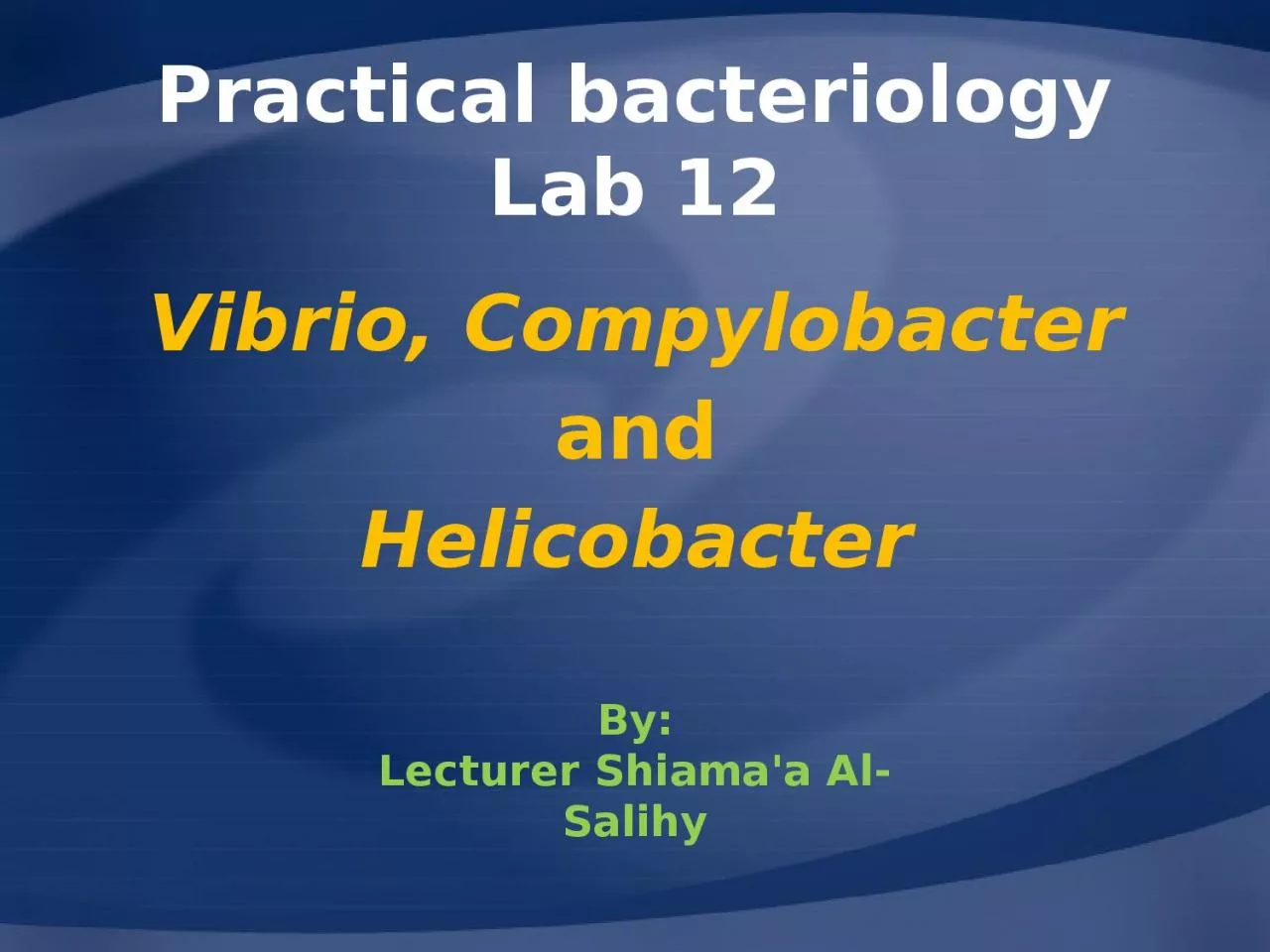

Vibrio Compylobacter and Helicobacter By Lecturer Shiamaa AlSalihy The most important species are V cholerae Campylobacter jejuni amp C coli Helicobacter pylori General characteristics ID: 1039533
Download Presentation The PPT/PDF document "Practical bacteriology Lab 12" is the property of its rightful owner. Permission is granted to download and print the materials on this web site for personal, non-commercial use only, and to display it on your personal computer provided you do not modify the materials and that you retain all copyright notices contained in the materials. By downloading content from our website, you accept the terms of this agreement.
1. Practical bacteriologyLab 12Vibrio, Compylobacter and HelicobacterBy:Lecturer Shiama'a Al-Salihy
2. The most important species are:V. cholerae Campylobacter jejuni & C. coliHelicobacter pylori
3. General characteristics:Causative agent of cholera (watery diarrhea)One of the most common bacteria in surface waters worldwide.Facultative aerobicCurved comma-shaped rods.Motile with polar flagellum.pH range 7.0 - 9.0 Oxidase positiveV. cholerae
4. Vibrio typing>200 serogroups based on somatic O-antigenO1 and O139 serogroups are responsible for epidemic choleraO1 serogroup subdivided into Two biotypes: El Tor and classicalThree serotypes: Ogawa, Inaba, HikojimaNote: biotypes are based on differences in biochemical reactions, whereas serotypes are based on antigenic differences). Non-cholera vibrio (NCV) or non-agglutinating vibrios (NAG) or non-O1 vibrio cholerae)
5. During epidemic, a clinical judgment is decisive. Specimens: Rice-water stools (Colorless, Odorless, Speckled with mucus)Culture:Enrichment medium: Alkaline peptone waterSelective medium: TCBS grow as yellow coloniesSerology test: anti O group 1 or group 139 antisera. Lab. diagnosis
6. Fluid replacement is essential Tetracycline. However antibiotic treatment is unnecessary Treatment:
7. Causing gastroenteritis.Rods with comma, S or “gull-wing” shape.Motile (darting motility) with polar flagellum.Microaerophilic, grow well in 42°C Oxidase positive.C. jejuni & C. coli
8. Specimens: diarrhea stoolCulture: microaerophilic (5% O2 +10% CO2) by using anaerobic jar and gas generating pack.Skirrow's medium (with vancomycin, polymyxin B, and trimethoprim) at 42°CColombia agarLab. Diagnosis:Skirrow's medium Colombia agar
9. Causing gastritis and peptic ulcer, risk factor for gastric carcinoma, linked to mucosal-associated lymphoid tissue (MALT) lymphoma.Curved Gram-negative rods.H. pylori
10. Lab diagnosis: Specimen: gastric biopsy by gastroscopy, can be used for (histological examination, gram-staining and culturing, blood for serology.) and stool.Smear: Giemsa or special silver stainCulture: on Skirrow’s medium ( containing Vancomycin, polymyxin B and trimethoprime, chocolate incubation at 37C for 3-6 days. Microaerophilic (5% O2+10% CO2)Urea breath test: radio-labelled urea is ingested. Urease will cleave the ingested urea, radiolabeled CO2 is evolved and radioactivity is detected in the breath
11. Treatment: Treatment of duodenal ulcers with: antibiotics eg, amoxicillin, and metronidazoleBismoth salts
12.
13. Practical bacteriologyLab 12Vibrio, Compylobacter and HelicobacterBy:Lecturer Shiama'a Al-Salihy
14. The most important species are:V. cholerae Campylobacter jejuni & C. coliHelicobacter pylori
15. General characteristics:Causative agent of cholera (watery diarrhea)One of the most common bacteria in surface waters worldwide.Facultative areobicCurved comma-shaped rods.Motile with polar flagellum.pH range 7.0 - 9.0 Oxidase positiveV. cholerae
16. Vibrio typing>200 serogroups based on somatic O-antigenO1 and O139 serogroups are responsible for epidemic choleraO1 serogroup subdivided into Two biotypes: El Tor and classicalThree serotypes: Ogawa, Inaba, HikojimaNote: biotypes are based on differences in biochemical reactions, whereas serotypes are based on antigenic differences). Non-cholera vibrio (NCV) or non-agglutinating vibrios (NAG) or non-O1 vibrio cholerae)
17. During epidemic, a clinical judgment is decisive. Specimens: Rice-water stools (Colorless, Odorless, Speckled with mucus)Culture:Enrichment medium: Alkaline peptone waterSelective medium: TCBS grow as yellow coloniesSerology test: anti O group 1 or group 139 antisera. Lab. diagnosis
18. Fluid replacement is essential Tetracycline. However antibiotic treatment is unnecessary Treatment:
19. Causing gastroenteritis.Rods with comma, S or “gull-wing” shape.Motile with polar flagellum.Grow well in 42°C Oxidase positiveC. jejuni & C. coli
20. Specimens: diarrhea stoolCulture: microaerophilic (5% O2 +10% CO2) by using anaerobic jar and gas generating pack.Skirrow's medium (with vancomycin, polymyxin B, and trimethoprim) at 42°CColombia agarLab. Diagnosis:Skirrow's medium Colombia agar
21. Causing gastritis and peptic ulcer, risk factor for gastric carcinoma, linked to mucosal-associated lymphoid tissue (MALT) lymphoma.Curved Gram-negative rods.H. pylori
22. Lab diagnosis: Specimen: gastric biopsy by gastroscopy, can be used for (histological examination, gram-staining and culturing, blood for serology.) and stool.Smear: Giemsa or special silver stainCulture: on Skirrow’s medium ( containing Vancomycin, polymyxin B and trimethoprime, chocolate incubation at 37C for 3-6 days. Microaerophilic (5% O2+10% CO2)Urea breath test: radio-labelled urea is ingested. Urease will cleave the ingested urea, radiolabeled CO2 is evolved and radioactivity is detected in the breath
23. Treatment: Treatment of duodenal ulcers with: antibiotics eg, amoxicillin, and metronidazoleBismoth salts
24.